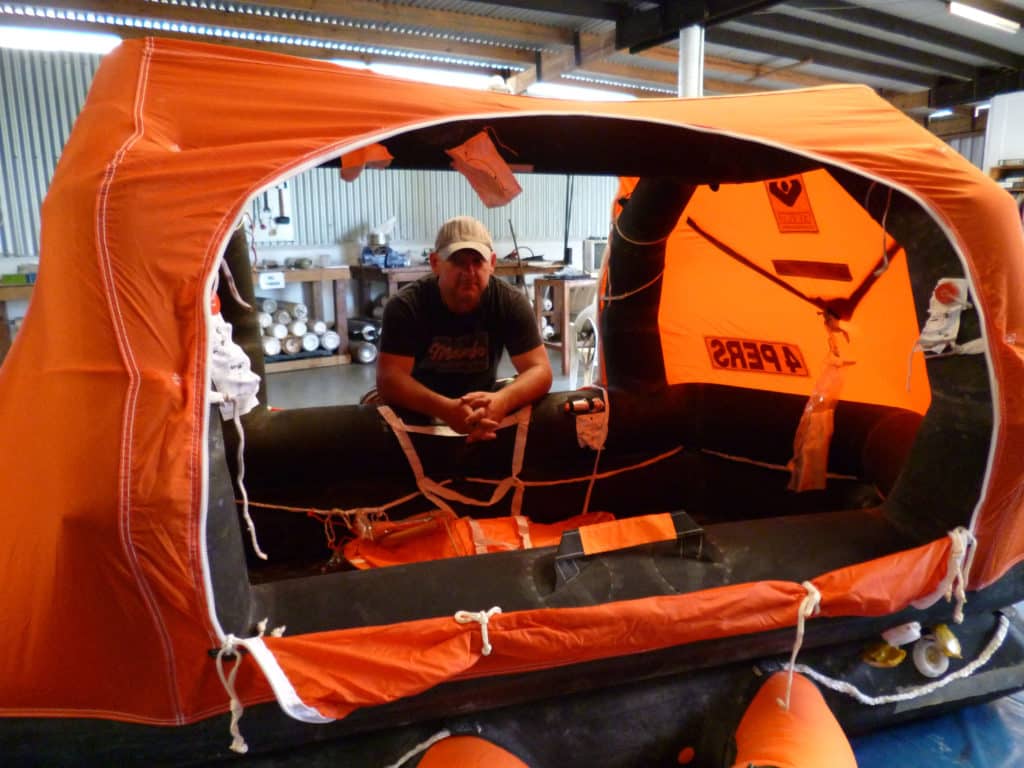
Fully inflated and sitting in the middle of the workshop floor, our life raft looked rather small. This wasn’t the first time I had seen a Viking RescYou four-person life raft in all its glory, but it was the first time ours had been unpacked from its tidy black valise.
We had gone way past the recommended service interval, but certified life-raft service centers aren’t that easy to come by in the South Pacific. Blown up, the raft reminded me of a children’s bouncy castle, all gaudy colors and rounded corners. The air was heady with the smell of new rubber like a freshly opened packet of balloons, but I felt no excitement as I crawled over the air-filled pontoons and into our escape pod.
I sat in the strange orange glow with my legs fully extended in front of me, imagining three other people sharing the space. It would be cozy, to say the least. Even with only Steve and me, the ditch bag and any other items we might manage to grab, it would be tight. I tried to imagine what the raft would feel like afloat; the floor constantly undulating, the sound of the ocean crashing around us, the slick, sticky feeling of salty skin and damp clothing. I struggled with the concept that my survival would depend solely on this small inflatable chamber and a few electronic gadgets. I closed my eyes and hoped that day would never come.
Spending time in a life raft is probably not on anybody’s bucket list, but any sailor who has spent a night or two at sea has no doubt stopped to consider the possibility. Like an EPIRB, a search-and-rescue transponder, a sea anchor and a good medical kit, a life raft is a vital piece of safety equipment that should be on board every boat. Some may think that life rafts are only the concern of offshore sailors, but hazards such as bad weather, accidents and human errors are not reserved for when you lose sight of land. A simple hop from port to port can be as treacherous as a three-week passage if you’re not prepared.
With so many brands on the market, it is difficult to know which life raft to choose, and unfortunately, talking to fellow sailors might not steer you in the right direction. Boat owners are often reluctant to foot the somewhat hefty expense of buying a new life raft if the one on board when the vessel is purchased is in serviceable condition, regardless of whether it’s the brand or style that they would prefer. The internet doesn’t have many firsthand user opinions on the matter because, thankfully, few boat owners have fully tested the limits of their equipment.
Still, there are several things to consider when buying a life raft, and the first should be the maximum number of people regularly on board.
The capacity of the life raft you carry is not determined by the length of your vessel but the number of crew who will need to use the raft in case of emergency. It is often recommended that you carry a life raft a size larger than the number of people on board. In our case, we sail almost exclusively as a couple, so we purchased a four-person raft. How the life raft performs at sea is somewhat dependent on the number of people inside it; the body weight of the passengers provides extra ballast. Although we were tempted to carry a six- or eight-man raft, it could actually be dangerous. An under-weighted raft is more prone to flipping if caught in a gust or when surfing down waves. A larger raft also means a larger space to keep warm, so maintaining core body temperature could become problematic. Large vessels will often carry more than one smaller life raft to accommodate varying numbers of crew and passengers.
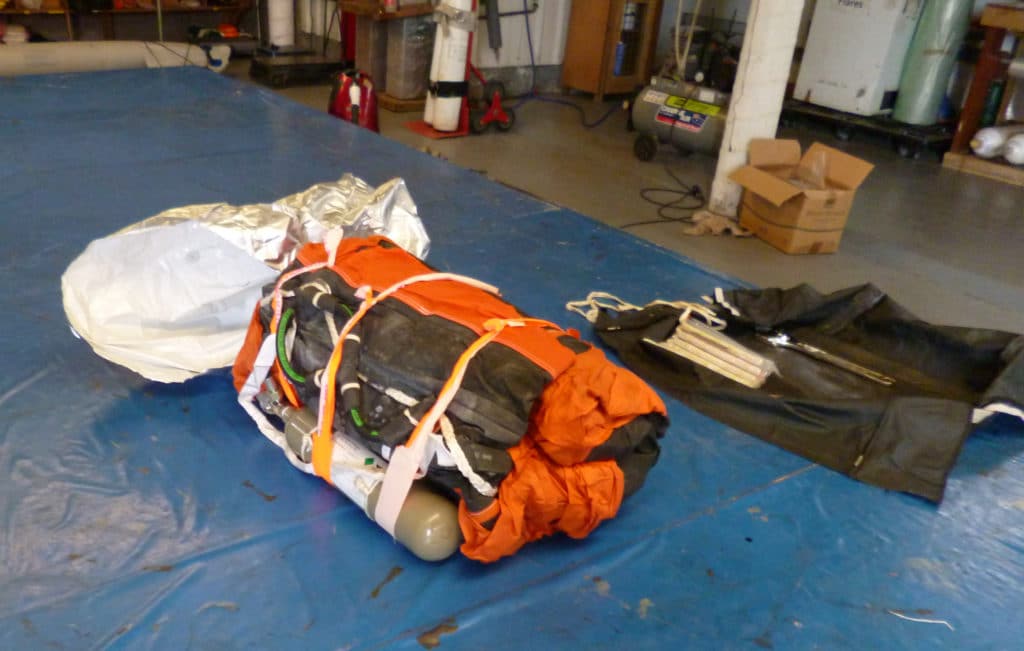
The physical dimensions and weights of life rafts vary from brand to brand but are mainly dependent on one thing: how they are packed. Whether to choose a soft valise or hard canister is perhaps the most debated point in the life-raft discussion. Of these, the canister-packed life raft is the most popular option by far. Out of the 20 boats that I surveyed, 15 vessels carried canisters.
Like any good debate, there are passionate arguments for and against both options. A hard canister is considered to be better protection from the harsh marine environment, but a valise can be stowed belowdecks, out of the weather completely. Storing a valise down below diminishes the possibility of theft. I personally have never heard of a canister life raft being stolen off a yacht, but even thieves can be safety-conscious.
A life raft packed in a valise is lighter than a canister, most weighing in between about 50 and 75 pounds, versus roughly 65 to 90 pounds for a canister. That said, a smaller crewmember might not be able to lift that much dead weight up the companionway, especially if the boat is heaving. A canister may weigh more but is usually deployed directly from its storage location. There are a few companies that offer ultralight life rafts packed in watertight cases, or will custom pack a raft to your storage specifications, but like anything light, small and customized in the sailing world, those options cost more.
The way the life raft is packed also determines where it is stored. The perfect storage spot for a canister life raft is a purpose-built compartment, as is often found in the transom of a catamaran. This type of system does not take up valuable deck space and, if davits and a dinghy are not obstructing the storage area, ensures the raft is easily accessible. The more common method of stowing a canister is in a custom mounting bracket, usually stainless steel or aluminum, which can be bolted to the deck or vertically on the rail. Although many cite canisters as being better protection against the elements, they can be prone to leakage if submerged in rough weather when green water is taken over the deck. So, mounting your life raft on the foredeck may not be the best option.
Canisters often are fitted with a hydrostatic release. This automatic device activates when submerged and inflates the raft if the vessel suddenly sinks. A “weak link” in the painter will part under stress, allowing the raft to float to the surface. It’s important to consider what obstructions might hinder the automatic inflation or release of the raft when choosing where to mount the bracket. Many boats have canisters mounted on the cabin top, which keeps it out from underfoot and away from the majority of heavy wave action. However, during deployment, it could get caught in the standing rigging, tangled in loose lines or come in contact with sharp hardware. Before drilling holes for mounting screws, take a look around for potential hazards.
The capacity of the life raft you carry is not determined by the length of your vessel but the number of crew who will need to use the raft in case of emergency. It is often recommended that you carry a life raft a size larger than the number of people on board. In our case, we sail almost exclusively as a couple, so we purchased a four-person raft. How the life raft performs at sea is somewhat dependent on the number of people inside it; the body weight of the passengers provides extra ballast. Although we were tempted to carry a six- or eight-man raft, it could actually be dangerous. An under-weighted raft is more prone to flipping if caught in a gust or when surfing down waves. A larger raft also means a larger space to keep warm, so maintaining core body temperature could become problematic. Large vessels will often carry more than one smaller life raft to accommodate varying numbers of crew and passengers.
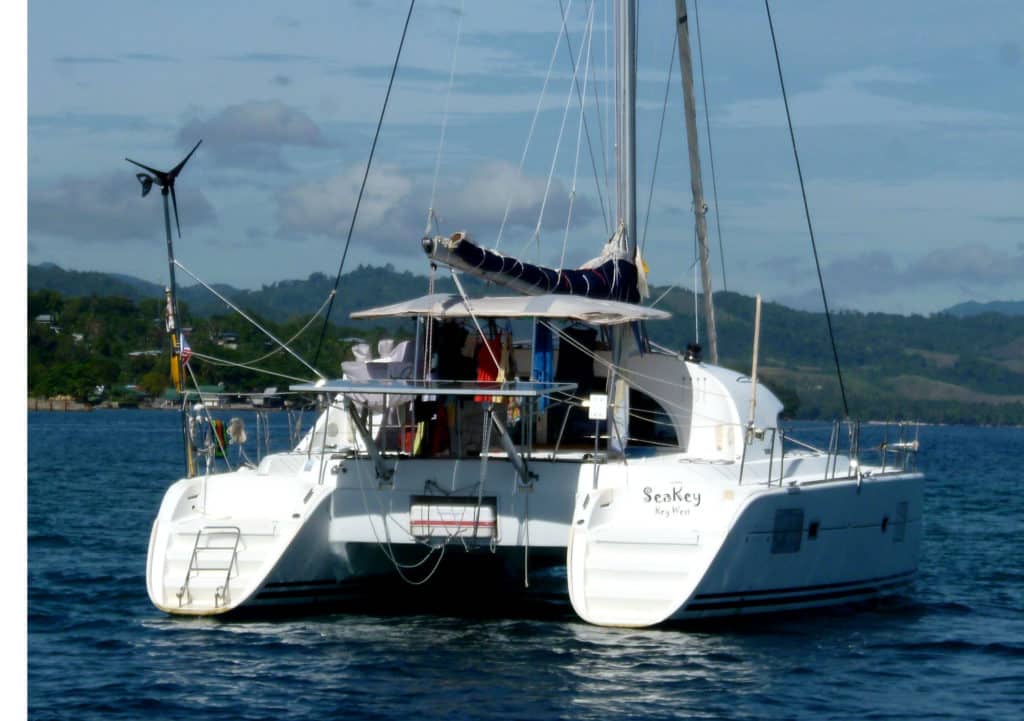
The physical dimensions and weights of life rafts vary from brand to brand but are mainly dependent on one thing: how they are packed. Whether to choose a soft valise or hard canister is perhaps the most debated point in the life-raft discussion. Of these, the canister-packed life raft is the most popular option by far. Out of the 20 boats that I surveyed, 15 vessels carried canisters.
Like any good debate, there are passionate arguments for and against both options. A hard canister is considered to be better protection from the harsh marine environment, but a valise can be stowed belowdecks, out of the weather completely. Storing a valise down below diminishes the possibility of theft. I personally have never heard of a canister life raft being stolen off a yacht, but even thieves can be safety-conscious.
A life raft packed in a valise is lighter than a canister, most weighing in between about 50 and 75 pounds, versus roughly 65 to 90 pounds for a canister. That said, a smaller crewmember might not be able to lift that much dead weight up the companionway, especially if the boat is heaving. A canister may weigh more but is usually deployed directly from its storage location. There are a few companies that offer ultralight life rafts packed in watertight cases, or will custom pack a raft to your storage specifications, but like anything light, small and customized in the sailing world, those options cost more.
The way the life raft is packed also determines where it is stored. The perfect storage spot for a canister life raft is a purpose-built compartment, as is often found in the transom of a catamaran. This type of system does not take up valuable deck space and, if davits and a dinghy are not obstructing the storage area, ensures the raft is easily accessible. The more common method of stowing a canister is in a custom mounting bracket, usually stainless steel or aluminum, which can be bolted to the deck or vertically on the rail. Although many cite canisters as being better protection against the elements, they can be prone to leakage if submerged in rough weather when green water is taken over the deck. So, mounting your life raft on the foredeck may not be the best option.
Canisters often are fitted with a hydrostatic release. This automatic device activates when submerged and inflates the raft if the vessel suddenly sinks. A “weak link” in the painter will part under stress, allowing the raft to float to the surface. It’s important to consider what obstructions might hinder the automatic inflation or release of the raft when choosing where to mount the bracket. Many boats have canisters mounted on the cabin top, which keeps it out from underfoot and away from the majority of heavy wave action. However, during deployment, it could get caught in the standing rigging, tangled in loose lines or come in contact with sharp hardware. Before drilling holes for mounting screws, take a look around for potential hazards.
Alternatively, mounting a raft on the rails of the stern pulpit will allow a mostly unobstructed deployment and make it easier for crewmembers to depart the foundering vessel from the cockpit. Wherever you decide to put the mounting bracket, it is important to use heavy bolts, lock nuts and a backing plate when necessary to prevent the raft from being accidentally washed overboard.
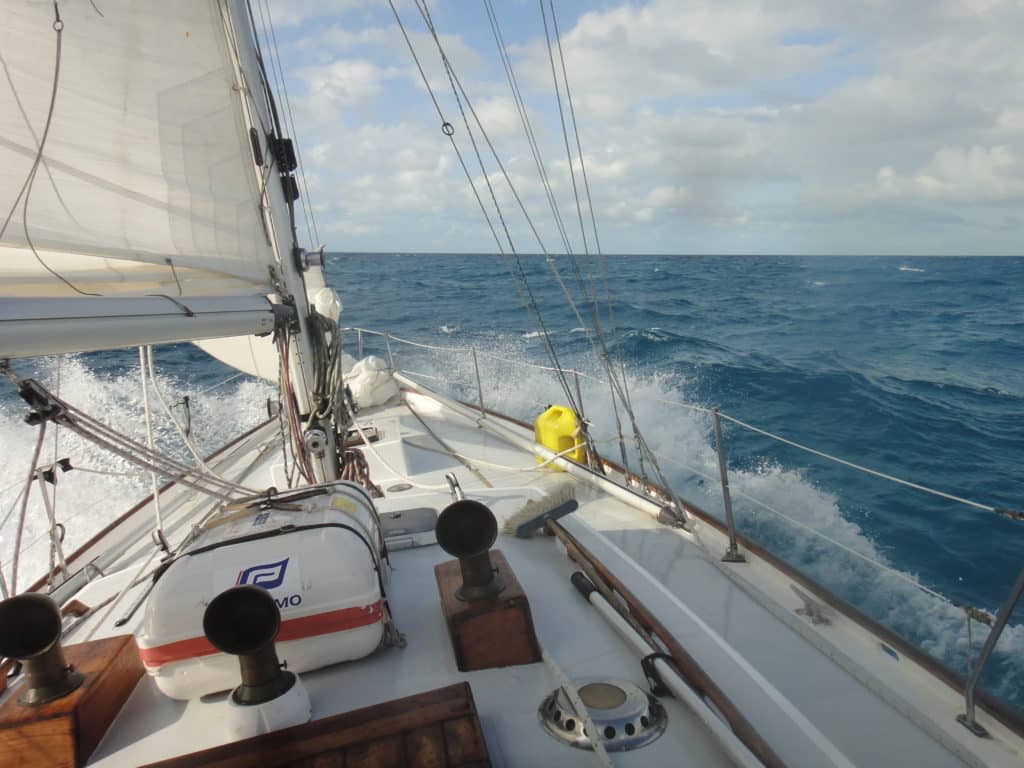
The most important consideration for storing a valise-type life raft is whether you have enough space to put the raft in a locker or belowdecks. A valise-packed raft is much more prone to water damage and chafe, so its storage location is a serious consideration. Many smaller vessels opt for a canister simply because they cannot accommodate storing a life raft down below. A dedicated locker in the cockpit would be the ideal spot for a valise, but only if you can guarantee the locker is free of leaks and sharp edges and is always accessible underway. If you store a raft in a locker it must be made clear to all crewmembers that nothing is to be placed on top of or around the raft that might hinder extracting it during an emergency. The minutes that you spend digging your way to the escape craft might just cost you your life.
A couple of the yachts whose owners I interviewed that carried valise-packed rafts stored them in the cabin while anchorage hopping, but the rafts were moved on deck while on passage. Both vessels had Sunbrella covers made, which provide excellent UV protection but only moderate defense against water. This system works in theory because most life rafts, both valise and canister models, are now vacuum-packed in heavy metallic bags to prevent water ingress, but it is not recommended.
On board Kate, our Newport 41, we store our life raft down below, just to starboard of the companionway, behind the nav table in a little nook that the designers considered a sea berth. From there, it is an easy grab and hoist up the stairs into the cockpit. Located nearby is our ditch bag, a Pelican case with boat documents and passports, the satellite phone and an empty extra-large dry bag. It’s one-stop shopping in case of emergency. I admit that I feel a bit like a Scotsman at a caber toss when maneuvering the beast up the companionway stairs, but I can do it without assistance or adrenaline.
What is often overlooked — and is of the utmost importance — is serviceability. After all, what good is carrying a life raft aboard if you cannot get regular safety checks and maintenance done on it?
Most manufacturers recommend having a life raft serviced every three years. Inspection should always be done by a certified service agent endorsed by your raft’s manufacturer. Each brand has specific packing techniques, test points and perishables on board that need to be examined and possibly replaced. If an unauthorized person services your life raft, the manufacturer is likely to void any warranty or responsibility if there are defects with the product or you experience an equipment failure. So where you are sailing and how long you’re gone should heavily influence which brand of life raft you buy.
In 2008, when we were fitting out Kate, we decided to carry a RescYou life raft made by Viking. Our initial plan was to sail from the United States to Australia, with a later possibility of continuing on to a circumnavigation. We looked at a number of manufacturers and, in the end, went with Viking because its life rafts are carried on cruise ships and container ships; it’s also the brand often used on gas platforms and oil rigs throughout the world. Worldwide sales means worldwide service. Although, as we found out, there are few service agents in the smaller islands of the South Pacific.
Many service centers will let you watch the inflation and inspection of your life raft, and I highly recommend taking them up on it. One couple from Washington that I spoke with reported they were even able to arrange a visit to the service center while shopping for a life raft so they could inspect the raft and all of its components before purchase. Getting to witness the mechanics of how a life raft is deployed and inflated means you will know what to expect when and if you need to do it yourself. Familiarizing yourself with the look and feel of the raft means there will be fewer surprises when you’re ready to crawl inside.
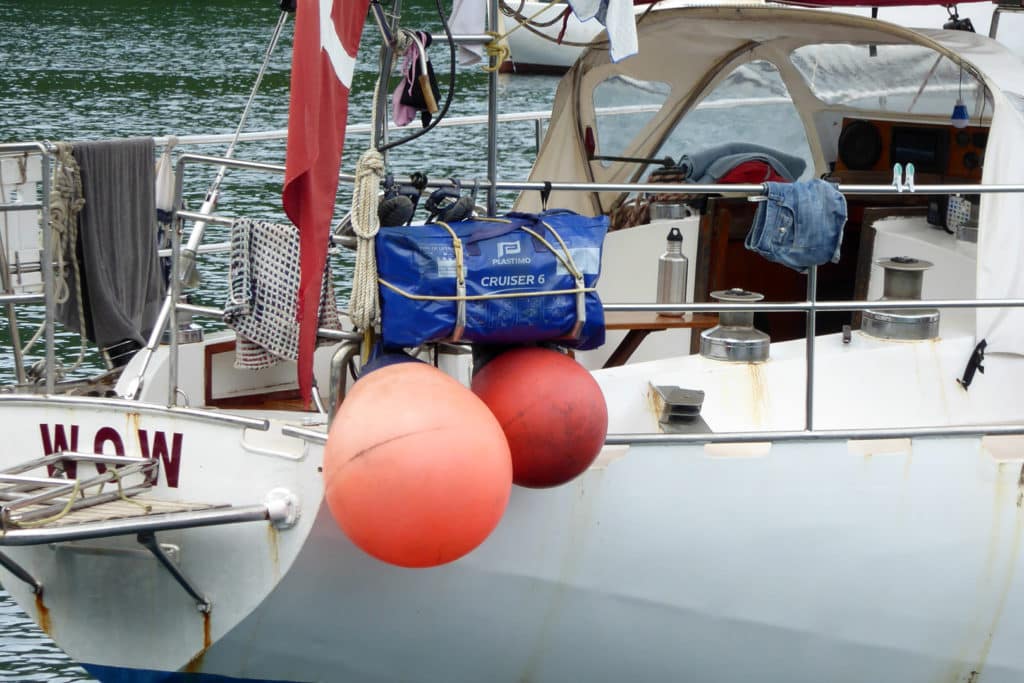
In a typical service, after breaking the seals on the canister or valise and cutting open the interior vac-pack bag, the technician will remove, inspect and weigh the CO2 cylinder that is included to inflate the raft. This process is similar to dive-tank inspections and is extremely important because a raft might not inflate when the painter is yanked if it has a faulty cylinder. The raft is usually inflated using an air compressor and left for several hours so that any pinholes or punctures have time to present themselves. During this waiting period, most service centers invite owners to get up close and personal with their life raft.
You should also get a chance to inspect the rations and safety gear included inside the raft. The inspector will have a checklist and should review that all items included in the raft are accounted for. They are required to check the expiration dates of medicines and rations and replace expired items with the same or equivalent item as compliant to the manufacturer’s standards. They will also inspect flares and replace those that have expired. The service center should have proper methods of disposing of any flares they remove from the raft.
The contents of onboard emergency packs vary by brand but should include seasickness tablets, water rations, a raft-repair kit, a manual pump, a bailer and sponge, a flashlight with extra batteries, a signal mirror, flares, a whistle and a pair of paddles. Items that are standard on some brands but must be added for an additional cost on other brands are food rations, a first-aid pack, a fishing kit, rain-collection and storage bags, a drogue anchor and extra water rations. Some manufacturers classify their emergency packs as “under 24 hours” and “over 24 hours,” while others state that what is included in the standard or extended emergency pack depends on “expected time that casualties may spend in the raft until they get rescued.” I, for one, am not expecting to be in my life raft at all, so knowing the duration of my stay in such a situation is impossible. In my opinion, it is prudent to purchase all the extras to make sure that the time spent in a life raft is as safe and comfortable as it can be.
A reputable service agent will ensure that all inspection tags that needed to be broken to service the raft are replaced. There is usually a sticker or tag affixed to the canister or valise where they will record their agent-specific ID number, date of service and next required service interval.
The cost of servicing a life raft fluctuates from port to port. The bill is usually broken down into a base service charge that includes unpacking, inflating, inspecting and repacking the raft. Any components that are required or supplies that are replaced are priced individually and then added to the base cost. When we got our raft serviced in Fiji in 2015, it cost $400. We had minimal items that needed to be replaced — seasickness medicine, water and flares. But, we found out, flares are considered hazardous goods when shipped so can be quite expensive when not purchased in their country of origin. Buying a life raft is neither a cheap nor easy exercise. Then again, the important affairs in life rarely are. There are many essential factors to consider, least of all the chance that you might actually have to use the thing one day. Cruisers are often said to be frugal, but this isn’t really the place to be pinching pennies. After all, how can you put a price on saving the lives of your loved ones?
– – –
Heather Francis is originally from Nova Scotia, Canada, and has been living and working on boats around the world for the past decade. In 2008, she and her Aussie partner, Steve, bought Kate, a Newport 41, in California, and have been sailing her full-time since. They plan to do a lap around the planet, albeit slowly. Follow their adventures at www.yachtkate.com.








